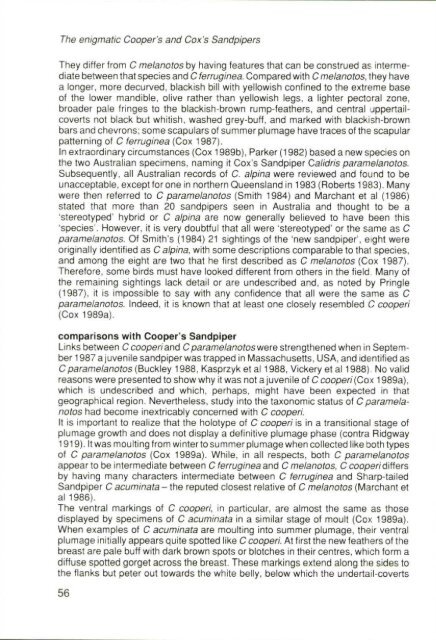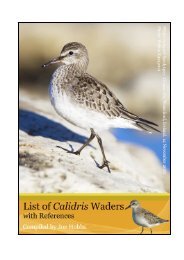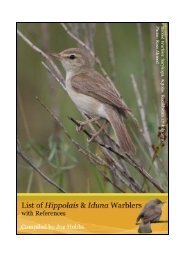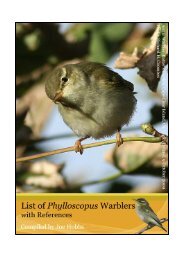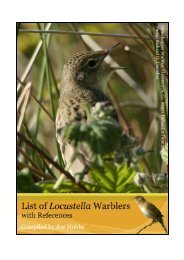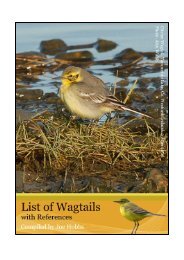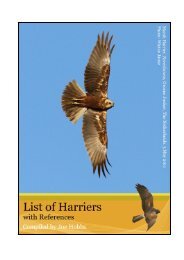You also want an ePaper? Increase the reach of your titles
YUMPU automatically turns print PDFs into web optimized ePapers that Google loves.
The enigmatic Cooper's and Coxs Sandpipers<br />
They differ from C melanotos by having features that can be construed as +ntermediate<br />
between that species and C ferrugrnea . Compared with C melanotos, they have<br />
a longer, more decurved, blackish bill with yellowish confined to the extreme base<br />
of the lower mandible, olive rather than yellowish legs, a lighter pectoral zone,<br />
broader pale fringes to the blackish-brown rump-feathers, and central ippertailcoverts<br />
not black but whitish. washed grey-buff . and marked with blackish-brown<br />
bars and chevrons: some scapulars of summer plumage have traces of the scapular<br />
patterning of C ferruginea (Cox 1987) .<br />
In extraordinary circumstances (Cox 1989b), Parker (1982) based a new species on<br />
the two Australian specimens, naming it Cox's Sandpiper Calydris paramelanotos.<br />
Subsequently, all Australian records of C . aipina were reviewed and found to be<br />
unacceptable, excepl for one in northern Queensland in 1983 (Roberts 1983) . Many<br />
were then referred to C paramelanotos (Smith 1984) and Marchant et al (1986)<br />
stated that more than 20 sandpipers seen in Australia and thought to be a<br />
'stereotyped' hybrid or C alpina are now generally believed to have been this<br />
'species' . However, it is very doubtful that all were 'stereotyped' or the same as C<br />
paramelanotos . Of Smith's (1984) 21 sightings of the 'new sandpiper', eight were<br />
originally identified as C alpina, with some descriptions comparable to thal species,<br />
and among the eight are two that he first described as C melanotos (Cox 1987) .<br />
Therefore, some birds must have looked different from others in the field Many of<br />
the remaining sightings lack detail or are undescribed and, as noted by Pringle<br />
(1987), it is impossible to say with any confidence that all were the same as C<br />
paramelanotos. Indeed, it is known that at least one closely resembled C cooperi<br />
(Cox 1989a) .<br />
comparisons with Cooper's Sandpipe r<br />
Links between C cooperiand C paramelanotos were strengthened when in September<br />
1987 a juvenile sandpiper was trapped in Massachusetts, USA, and identified as<br />
C pararrtelanotos (Buckley 1988, Kasprzyk et al 1988, Vickery et al 1988) No valid<br />
reasons were presented to show why it was not a juvenile of C cooperi (Cox 1989a),<br />
which is undescribed and which, perhaps, might have been expected in that<br />
geographical region . Nevertheless, study into the taxonomic status of C,oaramelanotos<br />
had become inextricably concerned with C cooperi.<br />
It is important to realize that the holotype of C cooperi is in a transitional stage of<br />
plumage growlh and does not display a definitive plumage phase (contra Ridgway<br />
1919) . It was moulting from winterto summer plumage when collected like ooth types<br />
of C paramelanotos (Cox 1989a) . While. in all respects, both C paramelanotos<br />
appear to be intermediate between C ferruginea and C melanotos, C cooperidiffers<br />
by having many characters intermediate between C ferruginea and Sharp-tailed<br />
Sandpiper C acuminata - the reputed closest relative of C melanotos (Marchant et<br />
al 1986) .<br />
The ventral markings of C cooperi, in particular, are almost the same as those<br />
displayed by specimens of C acuminata in a similar stage of moult (Ccx 1989a) .<br />
When examples of C acuminata are moulting into summer plumage, their ventral<br />
plumage initially appears quite spotted like C cooperi. At first the new feathers of the<br />
breast are pale buff with dark brown spots or blotches in their centres, which torm a<br />
diffuse spotted gorget across the breast . These markings extend along the sides to<br />
the flanks but peter out towards the white belty, below which the underta l-coverts<br />
56


